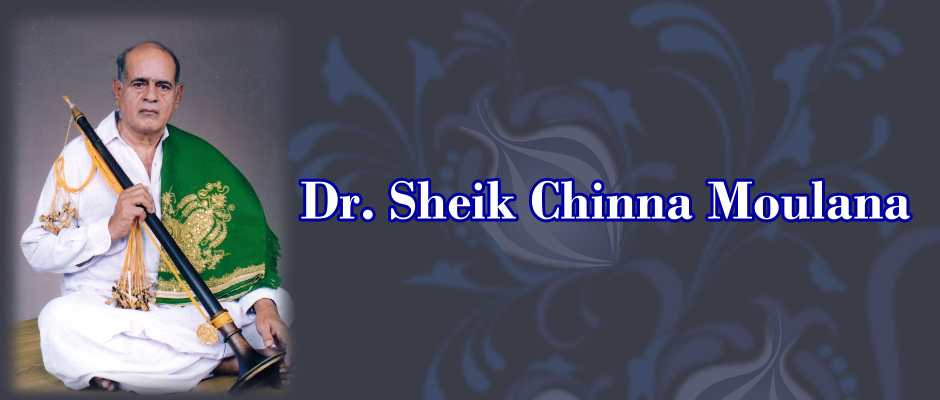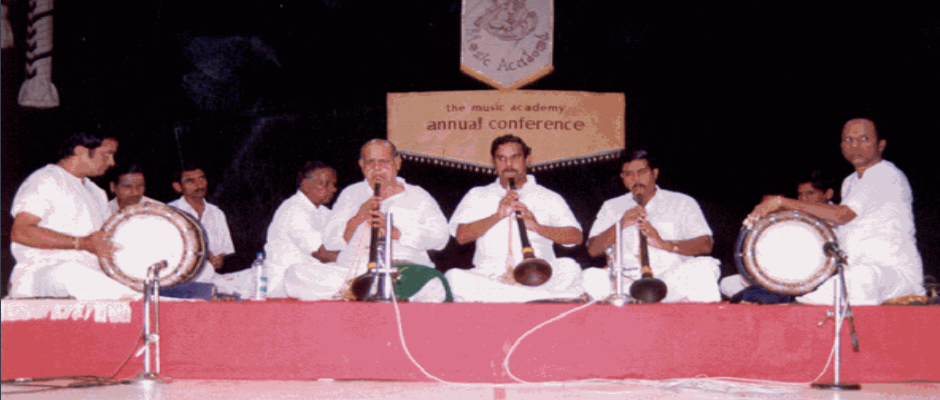Kasim & Babu - Our Tradition
The ancient and traditional art of Nadhaswaram playing has been preserved and fostered by the ancestors for the past 300 years. This art will also be taught, practiced and preserved by the future generation.
“Sisurvethi Pasurvethi Vethi Ganarasam Panihi” so goes the adage meaning that even children cows and cobras are enraptures and enchanted on hearing the Nadhaswaram music rendered by virtuosos and maestros.
Vidhwan Adam Sahib is known for his expertise in the “Ragha - Devagandhari” acclaimed as Deva Ganam and he was hailed by critics as one who proved the above saying to the hilt.
Vidhwan RAsavAripalem Kasim sahib was another great musician who was deeply learned and could answer any doubts on music and was endowed with a very vivid sharp memory. He was capable of using both his hands and feet two maintain Thala while singing Pallavi. He was nicknamed “The Cobra” and was the court musician of several samasthAnams like Gadwala samasthanam.
Kommur patcha sahib enriched the art of Nadhaswaram.
Vidhwan Chinna Moula Sahib and Pedda Moula Sahib of Chilakaluripeta were brothers. Chinna Moula was well versed in Sanskrit epics like Ramayanam and Amaram and could expound these epics in Telugu. The Thodi Ragha kriti “Munnu Ravana” and the niraval at the sahitya “Rajaraja Virajavaha” were excellently rendered by him on Nadhaswaram. He could sing the Krities like “Dhrona Karna” in the Ragha Simmendramadhyamam and elucidate the composition to bring home the meaning and bhava and render it on Nadhaswaram. He was honored with the title “Nadhaswara Sangeetha Vidhwan” by his contemporaries.
The Kommur brothers Pentu Sahib and Silar sahib were called geniuses. Pentu Sahib’s proficiency was revealed in several Krities like “Paridhanamichithe-Bilahari” “Endharo Mahanibhavulu-Sri” etc; He was called Kalyani Petu Sahib, Bilahari Pentu Sahib, Kedharagowla Pentu sahib - after the Raghas which flowed melodiously from his instrument.
Another pair of brothers Chinna Peeru Sahib and Peddha Peeru Sahib of Chilakaluripeta were famous for their proficiency in the Raghas Saveri and Abheri. Nagumomu- Abheri Ragha Kriti was Chinna Peeru sahib’s favorite piece. He was honored with the title ‘Nadha Brahma” by his contemporaries. While he was plying the Ragha Saveri in the temple of Goddess Kanaka Durga at Vijayawada a distinguished personality called Jonnavithula Seshagiri Rao who was present at that time said, “Chinna Peeru! The Goddess appeared before me, henceforth this Ragha shall be dedicated to the Goddess” which indeed a great honor to the artist who was able to evoke the Goddess with his music.
Sheik Adam sahib of Chilakaluripeta was the Guru of Dr.Sheik Chinna Moulana.
Sheik Abdulla Sahib (Dr.Sheik Chinna Moulana’s grandfather), Sheik Madar Sahib (Dr.Sheik Chinna Moulana’s uncle) and Sheik Kasim Sahib (father of Dr.Sheik Chinna Moulana) were also geniuses. The krities “EntharAni-Harikambhoji, Endhuku DhayarAdha-Thodi, Chakkani RAjamArgamu-Karaharapriya were their special pieces.
MY GURU
Sangeetha Kalanidhi Padmashri Dr.Sheik Chinna Moulana
“Guruvu Chillaginja - Guru helps obtain clarity
Guruve Brahmaramu - Guru helps to evolve
Guruve Bhaskarudu - Guru removes ignorance like the Sun
Gurude Bhadhrudaku - Guru bestows abundance”
“Nee chittamu- Thayagaraja Kriti - Dhanyasi Raga - Misrachapu”
It is indeed a great honor for me to write about my Guru and grandfather Sangeetha Kalanidhi, Padmashri Dr.Sheik Chinna Moulana, for World Space, on the eve of his birth anniversary. I thank the World Space radio for giving me this opportunity.
I was under the tutelage of my Guru from my childhood, till he passed away in 1999. It is very rare for any one to have one master as one and only guru that too the maternal grandfather. Though he was my maternal grandfather, I always treated him with the deference due to a guru rather than grandfather.
For Dr. Chinna Moulana, his father was his first guru, then he was under the training of Chilakaluripeta Sheik Adam Sahib and then to attain proficiency in the special “Thanjavur Bhaani” (style of Playing) he migrated to Tamilnad and took training from Nachiarkovil Sh.Durakkannu Pillai for a few years. So when he was moving from one school to another he faced lot of problems in absorbing different methods of teaching and he managed the problem with his sincere hard work and dedication. Hence he always used to emphasize on one guru and one school of thought. In that respect we were very fortunate.
Thiruvavaduthurai T.N.rajarathinam Pillai (TNR) was my guru’s maanasa Guru (Role-model). Though my guru had not directly inter-acted with TNR much, he attended many concerts of TNR and collected all the gramophone records of TNR. We used to wake up daily at 4.00am and listen to TNR’s records, closely observing his techniques and his style, and practiced the Sangaties till our Guru gets satisfied. While practicing, time was never to be considered a constraint.
When the Title of “Sangeetha kalanidhi” was conferred on my guru by the Music Academy, Madras, during the birth centenary year of the Nadhaswara Chakravarthy TNR, Sangeetha Kalanidhi Padmashri Dr.Sheik Chinna Moulana in his acceptance speech said, “I consider that in honoring me, the Academy is really honoring the great Nadhaswaram maestro TNR himself; accordingly I place the honor extended to me at the feet of Nadhaswara Chakravarthy Rajarathinam Pillai before accepting it myself.”
In his presidential address in the Music Academy, he was so candid and explained how great TNR’s music was.
I QUOTE:
Nadhaswara Chakravarthy T,N.Rajarathinam Pillai:
I wish to tell you a little about the music of Thiruvavaduthurai Rajarathinam Pillai as savored by me.
The Kauravas had only tasted defeat during the first eight days of the 18-day war between them and the Pandavas, as described in the Mahabaratha. Sanjaya, seated besides Dhrutharashtra, the blind king, was giving a running commentary on the war, as seen by him with his minds eye. Dhrutharashtra interrupted the narration at one point and asked; Sanjaya! How is it that, although the Kauravas have been experiencing defeat every day, Karna has not used against the Pandavas that powerful weapon of destruction (Sakthi Audha) he acquired with his own efforts? To this question, Sanjaya’s response was: Every night, upon retuning to our fortifications, our people decide that they would use the deadly weapon the next day, but they forget all about it when they go in to battle the next day. Like this, they forget about the weapon every day.
Similarly, after listening all night to the variations (Sangaties) presented by Rajarathinam Pillai in a concert, we would decide that we would capture them in our own presentations, but then, sure enough our memory of the variations played by Rajarathinam Pillai would become elusive and we would find we could play only the variations (Sangaties) we already knew !
I used to wonder, therefore, whether the music of Rajarathinam Pillai was beyond the human ken. The fact of the matter is none was equal to him except himself. In my perception he was not ‘Raja’rathinam Pillai; he was ‘Raga’rathinam Pillai. Unquote...
OUR SCHOOL:
Strict adherence to Sahitya patanthara and Raga Alapana are the two special features of our school. Our Guru taught all the kritis, pallavis, Javalis etc with complete sahitya which brings out the ‘Bhava’ even, when rendered in the Nadhaswaram. While teaching, he always emphasized the importance of sahitya, especially the krities of Muthusawmy Dhikshthar. He was against the habit of writing down the notations and the sahithya in paper. His view was “music must be taught and learnt like the Vedhas; all the krities must be memorized’. Thus we had our training of Geethams, varnams and krities orally and we were never allowed to use pen and paper. In the later days, of course sympathizing with our academic pre-occupations, he allowed us to take down the notations and sahitya in our note books. His method of teaching was very simple. He taught us the method of elaborating a raga say ‘Thodi Raga ’ for 10 minutes, 30 minutes or one hour. He also taught us the subtle differences between allied Ragas like Bhairavi-Mukhari, Anandhabahirani-Reetigowla, Anandhabhairavi-Huseni, Dharbar-Nayaki, Arabhi-Devagandhari etc,.
My Guru maintained a very good relationship with his contemporaries and also his seniors. Whenever his musician friends like Dr.S.Ramanathan, Veenai Duraiswamy Iyengar, Emani sankara sastry etc., met him he would not simply chit-chat... He would only discuss about music; Here I wish to narrate an interesting incident that happened during the wedding celebration of Ms Kalyani, the daughter of the veena Exponent Emani sankara Sastry. We were (My guru and myself) playing at the time of the wedding of kalyani at Visakapatnam. It was around 10.00pm. My guru was playing the Thyagaraja kriti ‘Inthasowkyamani’; after the elaborate kaapi alapana, my guru was playing cascading sangaties while he was presenting the anupallvi “Dhantha seetha Kantha”and at Charanam “Vararaga laya”. Emani’s prime disciple Veena maestro Mr.Chittibabu, who was sitting in the front row, was so overwhelmed that after the completion of the kriti, Chittibabu came on the dais and hugged my guru and requested him to play the kriti Inthasowkyamani once again. And my guru played the kriti once more to satisfy Chittibabu.
On another occasion my grandfather was rendering the Kedaragowla Kriti-Thulasi Bhilva during the Thyagaraja Aradhana at Thiruvaiyaru. After listening the Kriti Lalgudi Jayaraman and M.S. Subbulaksmi who were present among the pancharatna group came to my guru and told him that the entire ambience in the Pandhal was filled with Kedaragowla….
He gave equal importance and respect to all the accompanying artists. Valangaiman Sh.Shanmugasudaram Pillai, the thavil maestro was the perfect match for him. Sh.Shanmugasudaram Pillai accompanied my guru for more than three decades in most of the concerts including the AIR and TV programs.
In the matter of religion he had a very catholic attitude and in a way Music was his prime religion and perfection was his sole aim. He was well versed with the Ramayana and the Mahabaratha and in all discussions he used to freely quote anecdotes from the two epics.
He loved Hindustani Music very much and was fond of listening to the concerts of Abdul Karim Khan, Bade Gulam Ali Khan, Bismilla Khan Etc. Bismilla Khan and my guru were good friends. My guru adopted many Hidustani -Shenoy techniques (Styles) particularly while rendering the Ragas like Subhapantuvarali, SinduBhairavi, Yamuna Kalyani, Behag etc to bring out the unique melody of such ragas...
When Doordarshan was launched in India during the fifties, a Jugalbandhi concert of my guru with Bismillah Khan - was the first treat to the viewers. They played Kalyani (Yaman) for 45 minutes in that concert. During the concert Bismillah Khan noticed my Guru’s Sruti alignment and praised him after the program.
My guru led a very simple life; he was very kind-hearted and bore no malice towards anybody; he expressed genuine appreciation for talent wherever found; he always wanted to help the poor and he was very particular about Annadhanam.
We have established a Trust to cherish his memory; “Dr.Chinnamoulana Memorial Trust”. We are organizing his Memorial on April 13th, every year to pay tributes to him in a solemn manner. During the occasion we are organizing annadhanam, presenting purses to senior /indigent Nadhaswaram/Thavil artists and Nadhaswaram instruments to two poor students learning this art. We are organizing the event every year only liberal donations from music lovers and patrons.
As long as Nadhaswaram is played, my guru’s name will be echoed in the music world.
Entharo mahanubhavalu Antharikki vandhanamu…
By S.Kasim, Nadhaswaram artiste, disciple and grandson of Sangeetha Kalanidhi Dr.Sheik Chinna Moulana.
The author can be reached at nadhaskasim@yahoo.com






